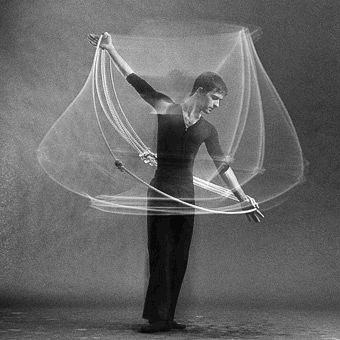|
When friends heard I was working with choreographer Andrew deGroat, they wanted to know two things: “Is he weird?” and “Does he make you spin?”
No, he’s not particularly weird. And no, he didn’t ask us to spin – though the latter surprised me as much as anybody. DeGroat, who was a painter and moviehouse manager until he met and started working with Robert Wilson, is famous for spinning – sometimes by himself, sometimes with other people, sometimes with ropes. He had been known to spin on stage non-stop for up to an hour, and, as Heavyman in Wilson’s 12-hour opus
The Life and Times of Joseph Stalin, he reportedly drew cheers every night for spinning for five minutes straight wearing three ape suits underneath his white costume.

While deGroat’s choreography for Wilson’s works (including the acclaimed
Einstein on the Beach) has been based on spinning, Red Notes
– the piece he brought to Boston as part of the “Event Works” series – consists mostly of pedestrian activity. In other words, lots of walking. The piece was originally performed at the Nova Scotia College of Art and Design by painters and sculptors with little or not formal dance training (like deGroat). It was similarly done in Chicago, and here the company comprised half artists (Mass. College of Art students in everything from photography to glass-blowing) and half dancer-types who showed up at an open audition. I stumbled in with this second group, though my dance experience amounts only to acting school, a brief stint at the Joy of Movement and lots of private boogying to the home hi-fi; several others were professionals. I got involved primarily out of curiosity about Robert Wilson, and the piece did incorporate several trademark Wilsonisms (imperceptibly slow movement, flown-in objects, music by Philip Glass). However, the choreography itself bore the unmistakable stamp of deGroat’s creative simplicity. Besides, it took only a week to rehearse, and it was great fun.
The first rehearsal introduced the basic walking pattern that would appear throughout
Red Notes: four steps forward, four steps back, then five, six, seven, jump to 11, back to four, back to 11, then repeat the whole thing: 4-5-6-11-4-11, always facing away from the audience. Several variations – changing directions and leaving out phrases – were added. Another exercise required walking, running, standing, and moving while counting to 3, 9, or 50 in unison aloud, in carol or silently to ourselves; this would be preparation for the longest section of the piece, a nine-minute improvisation. For another section, each dancer was given a separate movement and a path or “track” to follow across the stage, This would begin with one person doing his bit, and then the others being added one by one until the stage was full of crisscrossing tracks. These three exercises plus a simple chasse step provided most of the choreography, which took about a day to learn. The rest of the time was spent trying to synchronize the movement with Philip Glass’s maddeningly monotonous music, a 38-minute composition for organ, saxophone and voice from his
Another Look at Harmony series. At first, only Andy could discern any modulations in the dense, repetitive score. Little by little it sank in, and everyone absorbed at least the crucial
nine-counts-of- five cycle that cued several passages. But by the end of the week, it was still almost as much guesswork as precision that made the dancing end, as intended, with the music.
Whenever I’m in the audience for a theater piece that seems to have an arbitrary structure and/or no verbal content, I always wonder whether the performers themselves are operating within a “meaningful” framework that simply isn’t visible to the audience. With
Red Notes I can spell out the semi-arbitrary structure (all those numbers! More like mathematics than dance or theater!) but can’t connect it with any verbal content. No one ever asked “Andy, what does this mean?” or “Why 11-4-11?” or “Why are we all wearing red?” And the choreographer certainly didn’t volunteer any answers – though I think he mentioned once that the “track” section should look like rush-hour traffic and another time that the odd numbering was meant to avoid the standard 12-counts in dance (just as Glass’s relentless repetition omits standards tension-and-release mechanisms). Not that deGroat was aloof or tight-lipped. In fact, he was extraordinarily amiable, and he directed with such subtlety and personal charm that we seemed to be inventing the piece ourselves – even though all the movements came from him. But if he meant the piece to be “about” something, he didn’t give a clue.
In performance Red Notes seemed like a complicated game or puzzle that depended on everyone’s remembering the rules and all the pieces going in the right places. It reminded me of a dance called
Game Plan that I saw Bella Lewitsky’s company do at the Loeb a few months ago. And when there were technical errors, or I lost track of the count, it seemed like points lost, a losing game. So when I saw a videotape of the show, I was startled at its visual splendor – the monolithic strength of bodies simply walking back and forth, the illusion that that movement created of changes in the music where none existed, the stark lighting, the eerie religious presence of the cardboard-and-masking-tape set created by Bev Byrnes, one of the dancers. And beyond all that, the piece has had a wonderful after-effect: going about my business, I not only recognize in my usual stride
Red Notes’s walking pattern, I want to break out into the rest of the dance right there in the street.
Boston Phoenix, April 10, 1979
|